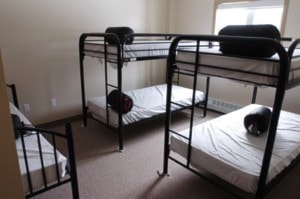The athletes’ village was sweating during the Canada Winter Games.
Humidity levels inside the rooms hit 80 per cent.
They should be closer to 25.
“I heard it was pretty bad,” said Keith’s Plumbing and Heating employee Ted Whitney on Thursday.
“Water was running right down over the window sill, down onto the wall and into the carpet.”
Keith’s Plumbing and Heating installed the athletes’ village ventilation system.
And it’s not set up to handle that many people, said Whitney.
“You got 18 people in a room,” he said. “That alone, without their wet gear and the stinky hockey gear, just having that many people in there is going to provide so much humidity in that room.
“But that on top of having the differential outside and inside temperature is just craziness.”
It wouldn’t have been so bad if the temperature hadn’t dropped dramatically during the first week of the Games.
“It’s exponential,” said Whitney.
“As soon as you hit that 30-below mark your car’s crying, your feet are crying and the same thing happens with your house — you can watch the ice grow.”
As a Games sponsor, Keith’s Plumbing and Heating kept three employees on call to deal with problems at the village while the athletes were in residence.
The plumbers pulled tennis shoes and clothes out of toilets, fixed a frozen water pipe after an outside door was left open for hours at minus 40, and spent time mopping up the dripping window sills and walls.
With skiers bringing in wet, snowy gear and everybody showering, it was just “craziness,” said Whitney.
“You couldn’t build a building that runs efficiently with 18 people in a 1,000 square-foot room, because after the fact it would only be for two weeks, then it would be overkill for the rest of its life,” he said.
Condensation and moisture can lead to mildew, rot and black mould, but Whitney doesn’t think this will be an issue at the village.
“If we were in Vancouver I would be worried,” he said.
“But it’s so dry up here, the athletes are out of there and the ventilation units are on constantly, so the air’s moving — eventually the relative humidity will drop and all the moisture will come out of that building.”
Yukon Housing is taking over the village, which will become housing for seniors.
The condensation isn’t a concern, said Yukon Housing technical supervisor Rick Laberge.
“Just people being in a building causes moisture,” said Laberge.
“Normally there will be one or two people in those rooms, and we had as many as 18, so mostly it was just the people being there and breathing.”
Every human puts about 4.54 litres of water into the air daily and when that many people are sleeping in closed rooms it’s even worse, he said.
Mould would be a worry if moisture got inside the walls, said Whitney.
“But it was just surface stuff.”
“It ran on the outside of them; we don’t even have any water stains from it,” said Laberge.
But ventilation contractor Mike Youso isn’t so sure.
“I wonder about it being in behind the walls,” he said.
“It can get in there, and it’s quite likely.”
Inadequate window detailing can shed moisture in the walls, he said.
This is especially common in prefabricated buildings, like the athletes’ village.
“From my experience with mobile homes and other manufactured buildings, they don’t have good attention to moisture detailing around window interiors,” said Youso.
“It could very well be we’ve got a whole lot of buildings designed for Alberta that may not work that well up here when it dips down to minus 30 for a week or so —and they didn’t already.”
Northerm provide the triple-pane, low-E coated windows for the village, but didn’t install them.
“I’m not sure how they finished them off,” said a Northerm employee.
“We didn’t do the interior sill extensions for them.
“Typically if you silicone it you don’t have to worry about any water running down.
“We usually do it here, but we sent (the windows) down to Calgary and they were installed there and then shipped back up.”
Mould shouldn’t be a problem if the condensation is evaporating, said Youso.
“If the moisture in the carpets is drying up, we can reasonably assume the moisture in the walls is drying up too.”
The worst thing they could do is turn off the heat and ventilation, he said.
“They have to keep the heat up and the ventilation going,” said Youso.
“It might cost a few bucks to do this, but if they don’t get the moisture out of there it’s going to cause lots of problems.”
